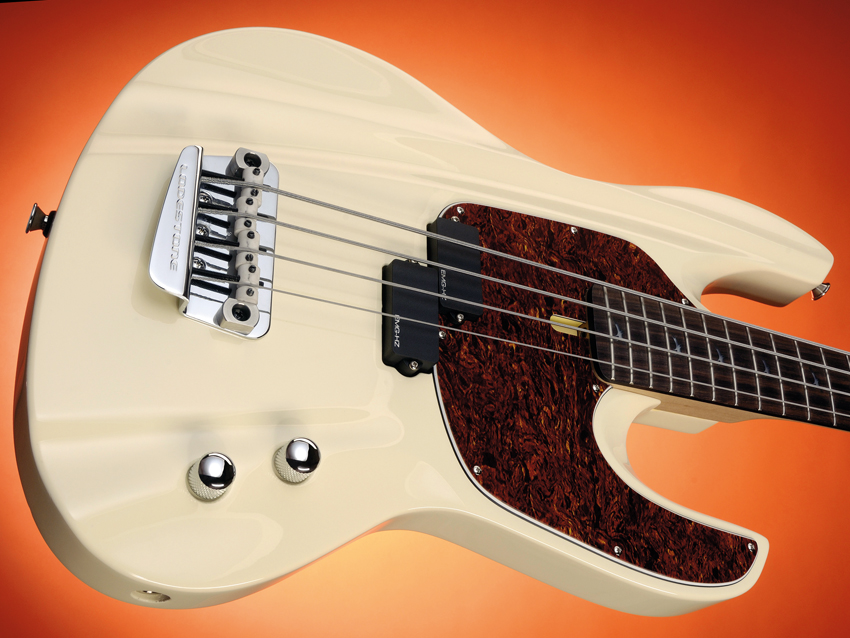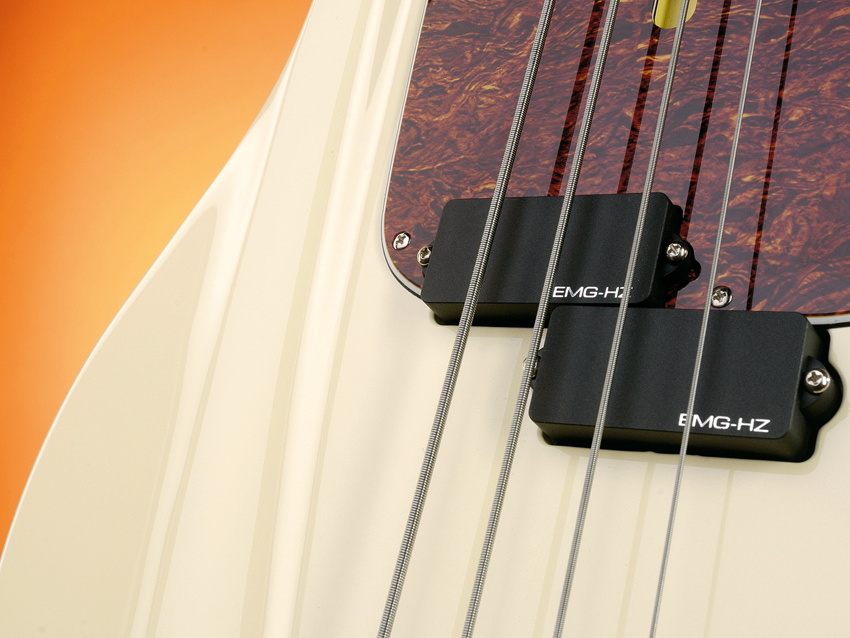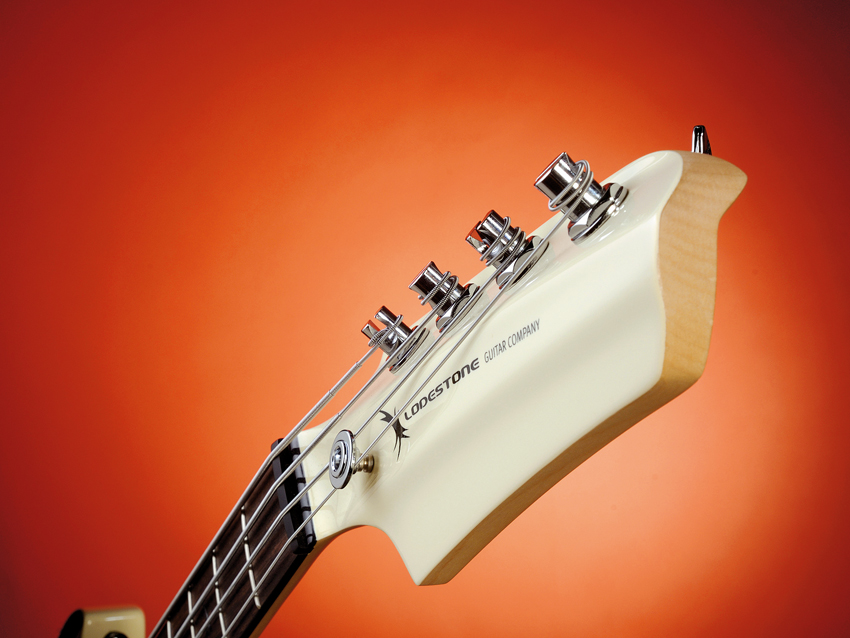MusicRadar Verdict
Not just another inspired-by-P Bass instrument, this has much to offer with individual style and tone. Add it to your must try list!
Pros
- +
Modern slant on old recipe. Surprising tonal range.
Cons
- -
The forearm chamfer is not a smooth transition so may not be to everyone's taste.
MusicRadar's got your back

Lodestone Primal Instinct

Lodestone Primal Instinct

Lodestone Primal Instinct
When British bass amplification expert Mark Gooday left the Trace Elliot Company and started his soon-to-be-popular Ashdown range, one of the casualties of the move was the T-Bass.
This was a calculated and much-researched entry into the bass guitar market by Trace Elliot. It was a bold statement that offered several innovations, but by far the most striking was the curious 'LaidBack' headstock design that presented both ergonomic and practical advantages.
Sadly all of that seemed to be lost to the past until Gooday revised the ideas (and added some more) when producing the Lodestone guitars and basses. Better still these models are made in the Czech Republic under the watchful eye of Ashdown, meaning you get a lot of bass for your money.
First examples of the Lodestone Bass, with off-set bodies and dual single-coil pickups, were obviously inspired by Fender's mighty Jazz, but here we are presented with a healthy touch of the Precision as well by way of the EMG-HZ split-coil pickup with passive circuitry and a wider-than-Jazz Bass fingerboard width.
The offset body remains, however, and although this is essentially slab in style it has been given a very dramatically carved top. It's only when looking from a short distancethat you appreciate that the curves in the surface actually make arcs that reappear on the headstock, and that's curiously pleasing.
There is further continuity in the way the upper and lower body horns are 'nipped off' in line and this all helps to emphasise this clever design statement.
But as it was with the T-Bass it's that headstock design that causes the most controversy, for even though it certainly works from a practical point of view many players still find it a little, er, disturbing visually. In reality it's easy to use and ensures good string seating, while the extra mass, is said to improve sustain and tonal warmth.
The neck offers a typical American-style profile and the fingerboard is relatively flat so the general feel is more Lakland than Fender. Beneath this rosewood fingerboard carbon fibre rods are inserted to add strength to the neck and introduce extra sonic properties. The 'claw' inlays are both visually striking and offer a refreshing deviation from the usual dots or slabs.
There's another move away from convention in the shape of the bridge for, although it's of raised tail design, it's equipped with substantial individual ceramic saddles sandwiched between anchor blocks to prevent lateral movement.
The whole thing is extremely solid, the string ends are fully concealed and the asymmetric shape neatly follows the curve of the body edge. The choice of ceramic for the saddles is an unusual one but it's a very hardwearing material (used in the braking systems of racing cars among other things) and is said to allow string vibration to pass through to the body more easily, thus 'improving' tonal quality and sustain.
The dominant feature on the body is the tortoiseshell scratchplate that provides a respectful nod to the past and looks really good on this creamy white finish. It also has a very obvious truss rod access slot highlighted here by the cream finish that shows through - perhaps it will be less obvious on the sunburst model.
Essentially a slab body bass, then, with a strikingly contoured top that allows the controls to sit neatly within a ripple on the surface. With the headstock and body given the same first-rate finish and the jack socket out of sight on the edge this is a very fresh and pleasing presentation.
Sounds
Any bass fitted with a split-coil pickup is going to produce that certain something in its sound imprint that many of us find so appealing. Hardly surprising as it offers a no-nonsense delivery that is always full and fat and provides a really solid foundation for any band, no matter what style of music is involved.
And indeed the Lodestone is definitely true to form. However, there is a certain something extra that it possesses within its voice.
One thing that's curious is that, although this is equipped with a passive circuit, there is a lot more tonal contrast that becomes apparent as you rotate the tone control. In fact there is something of a parametric quality as you move towards the bass end of the control, which is a most unexpected and pleasing quality.
Of course, much of this fruity sound is made possible by the excellent EMG pickup but credit must also be given to the body proportions, the substantial amount of wood in the headstock, the carbon neck reinforcing rods and, of course, those ceramic saddles. Each plays just a small part but collectively they give this bass a sound of its own.
With generous string spacing and an uncluttered body surface this is a bass to appeal to all styles of players. Ample room for pull-offs and slap and plenty of places to dig in if you're a hard rocking pick player.
You have the means to do whatever you do best with ease and deliver a mightily solid sound that will leave no one in doubt that you mean business. And without the blending capabilities of a twin pickup configuration it's essential to have plenty of solid projection, which the Instinct provides by the bucket load.
In case you're wondering, in spite of the increase in headstock mass the balance of the Instinct is very good.
Over the years we've seen a plethora of basses inspired by the classic models and, yes, we've reviewed a good many too. But although this Lodestone takes its initial inspiration from obvious sources, the designers have managed to add a fair share of originality too.
There are cheaper variations on this theme but few offer so much originality of design. So with its slab body outline and contoured top, striking cutaways, powerful pickup and unusual headstock this may be a bass rooted in the past but in so many ways it looks to the future. Try one soon and, like us, you might be more than pleasantly surprised.
“Built from the same sacred stash of NOS silicon transistors and germanium diodes, giving it the soul – and snarl – of the original”: An octave-fuzz cult classic returns as Jam Pedals resurrects the Octaurus
What’s the buzz? Meet Yellowjacket, Cherry Audio's recreation of EDP’s trend-setting Wasp from 1978
“A fabulous trip through all eight songs by 24 wonderful artists and remixers... way beyond anything I could have hoped for”: Robert Smith announces new Cure remix album









